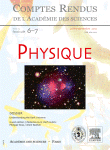
Volume 13, Issues 6–7, July–September 2012, Pages 682–718
Understanding the Dark Universe
Edited By Philippe Brax and Celine Boehm
Establishing homogeneity of the universe in the shadow of dark energy
- a Astrophysics, Cosmology & Gravity Centre, University of Cape Town, Rondebosch 7701, South Africa
- b Department of Mathematics and Applied Mathematics, University of Cape Town, Rondebosch 7701, South Africa
- Available online 12 July 2012
Abstract
Assuming the universe is spatially homogeneous on the largest scales lays the foundation for almost all cosmology. This idea is based on the Copernican Principle, that we are not at a particularly special place in the universe. Surprisingly, this philosophical assumption has yet to be rigorously demonstrated independently of the standard paradigm. This issue has been brought to light by cosmological models which can potentially explain apparent acceleration by spatial inhomogeneity rather than dark energy. These models replace the temporal fine tuning associated with Λ with a spatial fine tuning, and so violate the Copernican assumption. While is seems unlikely that such models can really give a realistic solution to the dark energy problem, they do reveal how poorly constrained radial inhomogeneity actually is. So the bigger issue remains: How do we robustly test the Copernican Principle independently of dark energy or theory of gravity?
Résumé
Lʼhypothèse que lʼunivers est spatialement homogène à grande échelle est au fondement de presque toute la cosmologie. Cette idée est basée sur le principe de Copernic, qui érige que nous ne tenons pas une place particulière dans lʼunivers. De façon surprenante, cette hypothèse philosophique nʼa pas encore été montrée indépendamment du paradigme standard de la cosmologie. Ce problème a été mis en exergue par des modèles cosmologiques qui peuvent expliquer lʼapparente accélération en utilisant lʼinhomogénéité spatiale plutôt que lʼénergie noire. Ces modèles remplacent lʼajustement fin associé à la constante cosmologique par un ajustement spatial, et ainsi violent le principe de Copernic. Même sʼil semble peu probable que ces modèles donnent une solution réaliste aux problèmes de lʼénergie noire, ils révèlent cependant notre ignorance de lʼinhomogénéité radiale de lʼunivers. Ainsi reste un probleme épineux : comment tester de façon robuste le principe de Copernic indépendamment de lʼexistence de lʼénergie noire ou de toute théorie de la gravité.
Keywords
- Dark energy;
- Spatial inhomogeneity;
- Gravity theory
Mots-clés
- Énergie noire;
- Inhomogénéité spatiale;
- Théorie de la gravité




